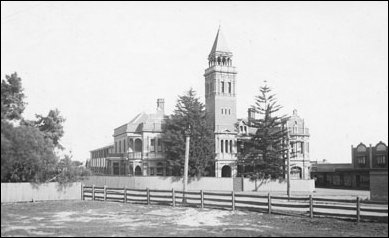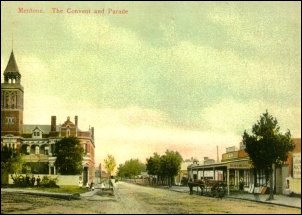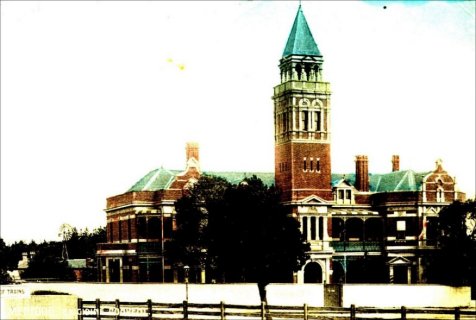The Mentone Coffee Palace

Tower of Kilbreda College 1997. Photograph by John Madge.
The arrival of the first train in the small hamlet, which had sprung up on Balcombe's Road, in what we now know as Mentone, resulted in a surge in building and development through the early 1880s. The train line extended at that time to Mordialloc, which, along with Cheltenham were the district's larger, more established towns.
By the end of the decade, in addition to the many fine houses, which had been built by successful "landboomers", speculators and businessmen, Mentone also had an impressive beachside hotel. Located in a superb position, panoramic views of Port Phillip Bay could be had from its balconies and many a holiday-maker took advantage of the baths which were situated nearby.
The area was developed as a tourist precinct, given exotic names, which those of southern European background could recall visiting, and about which others had read, heard or dreamt. Streets such as Como Parade, Venice Street, Naples Road and Florence Street were intended to create the more sophisticated European atmosphere to attract investors and buyers to what was to become Melbourne's riviera with facilities such as the baths, railway and other impressive buildings.
The coffee palace, as an alternative to hotels, was an American concept introduced to Melbourne in a number of places in the 1880s. A group of men saw the potential of this form of accommodation for Mentone, a boom but underdeveloped area located a pleasant train journey from the city. They formed the Royal Coffee Palace Company Limited, Mentone, in June 16, 1887 intending to establish temperance premises where “no wine, ale or spirituous or intoxicating liquors” was sold. Other potential activities for the new company were also listed in the Articles of Association including carrying on the business of a livery stable, and conducting a farm. Perhaps more unusual were the objectives of buying, selling and mortgaging freehold or leasehold estate; receiving money on loan or deposit and the issuing of debentures, bills of exchange and promissory notes.
The Articles of Association for the new company named ten men who held 5100 shares between them with Matthew Henry Davies being the largest and most significant shareholder with 2500 shares. Charles Hetherington, an accountant from Hawksburn, was the second largest shareholder in the new venture, holding 1000 shares. The other shareholders held between 500 and 100 shares each.
Of the shareholders, none were residents of Mentone although Matthew Davies had a property on Mentone Parade, on part of the site now occupied by St Bede’s College. Like himself two others investing in this new company were solicitors, his own partner in a law practice, Charles Wighton being one. There were four accountants, one medical practitioner from Toorak, a ‘valuator’ from Brighton and one gentleman.
A piece of land, close to the station was obtained, a bit more than an acre in all, bounded by Como Parade, Florence Street and Mentone Parade, and was purchased in 1887 from the National Land Company. Three years later, another parcel of land, bounded by a series of lanes and rights of way, behind allotments intended for housing and shops in Como Parade, Mentone Parade and Commercial Road was added to their holdings.
Davies’ vision of a township dominated by this building, its crowning glory, was to be realized late in 1887. But first, the formal laying of a memorial stone had to be undertaken. This event was largely attended, the Cheltenham Leader of August 17, reporting that “a very large number of local residents and visitors gathered …as …Mr. Smart, of the firm Messrs. Reed, Henderson & Smart, architects for the building, presented … to the Hon. M. H. Davies, a very handsome silver trowel with which to perform the ceremony.”
Davies took the opportunity to speak of the rapid development of the town, saying that “it had been necessary two build a Coffee Palace which, besides being an ornament, would also provide a long-felt want, namely, that of a first-class hotel.”
Mr. C. J. Potts’ call for “Prosperity for Mentone” was a sign of the prosperous times being experienced so explicitly in the 1880s Mentone. Such was the prosperity, that the workmen building the Coffee Palace were given an extra day’s pay “to commemorate the occasion.”
By October, the newspaper reported that Mentone was “still moving rapidly forward. The coffee palace will soon be ready for opening.” However, a death knoll of sorts was sounding already as it was also reported that “tenders have been called for a large hotel.”

Kilbreda Convent c1930.
The Coffee Palace's heyday was short-lived, with the hotel, closer to the beach and providing alcohol and accommodation, taking the bulk of the town's tourists. A little over a year after the company was formed nine of the original ten shareholders had disposed of their investment. Charles Samuel Price, a solicitor of Armadale was the exception, still holding his 100 shares. In February 1892, the company applied for a mortgage to the Mercantile Bank. An extraordinary meeting of shareholders was called the following month to advise them of the company’s financial difficulties. The recommendation that the company be wound up voluntarily was placed before them. They agreed to accept it and by January 1895 the process of liquidation was completed.

This post card c1904 shows the view from Mentone Parade and Florence Street The fence shown in this photo was removed in 1935 when the present brick wall and ornate gate were erected in memory of Mrs McGuffie who died that year.
As the 1890s progressed and the repercussions of the financial crash were felt far and wide, the building fell into disuse and later disrepair as only a few of its rooms were used for commercial purposes. The photo above shows the building a few years after this time. Some children are in front of corner door which originally lead to the Street Level Bar and further to the left are some members of the Brigidine congregation. The extent of the original building along Mentone Parade is also evident in this photo.
The early proprietors of the premises were mostly women, as the Sands and McDougall’s Directory entries for Mentone for the years prior to 1903 show. In 1894, one of the shareholders, Daniel J. Kekwick, was listed as caretaker, but prior to that, from 1889-91, a Miss McCartney was listed as manageress, Miss E. Gray, in 1982 and Mrs Moon was managing the place in 1893. Following Mr. Kekwick’s listing 1894, a Mrs Elizabeth Clark became proprietress from 1895-8, Miss E. M. Plummer in 1899 and Mrs Susannah Person in 1900.
In 1903 William Meader became the proprietor of the building which had become known as Como House. It was advertised as follows in the local press alongside hotels in Mordialloc, Cheltenham, Black Rock and Mentone.
COMO HOUSE,
MENTONE PARADE
MENTONE.
Near Railway Station and Beach.
______
Under New Management.
_______
Superior Accommodation for
Travellers and Visitors.
Best brands of Wines always in stock.
WILLIAM MEADER,
Proprietor.
Meader was battling against long established premises and his success in Mentone was limited. Attempts to sell the property were not successful, as many were wary of the possibility of further financial unrest. The building was neglected until mid 1904, when the local community was astonished to see that a local man James McGuffie, from Aspendale, had apparently purchased it. Much consternation was felt later, when it was discovered that McGuffie was acting for a Catholic religious congregation, the Sisters of St. Brigid, who intended to use the building as a convent and school.
The sisters had discovered the property while attending Mass at St Patrick's church, which at that time was next door to the Coffee Palace, on Como Parade. The sisters involved were from a convent in Echuca and had come to holiday at a bayside residence rented by Mr Michael Callanan, the father of one of the sisters. While there, they would travel to Mentone for Mass, and it was on such a journey that the Parish Priest of the Parish of Elsternwick, which included St Patrick's Mentone, Father Gough, suggested to the sisters that they start a school in Mentone.
The Brigidines purchased the property for £2050, which was considered, according to the local press, as quite a deal less than the property would have brought had it gone to public auction. The Moorabbin News noted that the "palatial buildings ‘Como House’ had changed hands. The main building which cost £16000 to build, and occupies two and three quarters acres in the heart of Mentone, together with large stables, tennis courts, etc., and a brick building, known as the old post office, which alone cost £850 to erect. The whole of these together with the furniture which cost when new over £1000 was purchased by a Roman Catholic orginisation (sic) for the ridiculous sum of £2000."
In the few days following the purchase, a handful of sisters and various friends and members of the local Catholic community, took on the huge task of cleaning and preparing the building for opening and blessing by the Catholic Archbishop of Melbourne, the Most Reverend Dr. Carr. One of the earlier members of the community left a description of the building as they had found it.
"A front entrance opens on an ornamental foyer, in the background of which is a stainglass window of elegant design. On the left, a large room, known as "Smokeroom" reserved for the leisure of gentlemen guests. Further left, was the ballroom with the verandah and cloak rooms opening on to a tennis court and lawn. On the right of the entrance, was a large guest room furnished with antiques - valuable Chippendale and Sheraton chairs and tables with matching furnishings. Six steps led to the Street Level Bar, and booking offices. Left of these was the commodious dining room with french doors opening on a verandah and lawn; the latter bordered with tree-ferns and selected shrubs offered relaxation in easy chairs, if desired. The pantry and storerooms led to a well-appointed kitchen beyond which were the fuel and tool sheds. These appartments (sic) were duly converted into class rooms and fitting appointments for the pupils' use." The job which faced them gives further details of the state of the building as it was in 1904. "They began their task with the removal of hundreds of cockroaches from their haunts in the kitchen, pantry and storerooms, together with the layers of dust covering everything everywhere on the ground floor and likewise, the first floor with its bedroom suites and single rooms. Dust and rubble were in quick time removed and the bird-infested tower were cleaned of accumulated refuse."

This photo shows the building in 1909, with various outbuildings and a windmill to the left of the picture, which may have been the shelter sheds and toilets of St Patrick's school.
